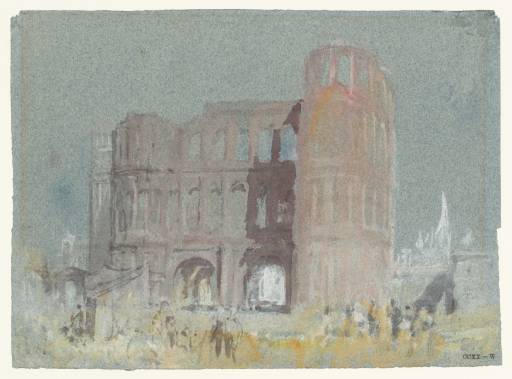Joseph Mallord William Turner The Porta Nigra, Trier c.1839
Joseph Mallord William Turner,
The Porta Nigra, Trier
c.1839
Joseph Mallord William Turner 1775–1851
The Porta Nigra, Trier c.1839
D20230
Turner Bequest CCXX W
Turner Bequest CCXX W
Gouache and watercolour on blue wove paper, 138 x 190 mm
Blind-stamped with Turner Bequest monogram bottom right
Stamped in black ‘CCXX–W’ bottom right
Blind-stamped with Turner Bequest monogram bottom right
Stamped in black ‘CCXX–W’ bottom right
Accepted by the nation as part of the Turner Bequest 1856
Exhibition history
1904
National Gallery, London, various dates to at least 1904 (628a, as ‘Porta Nigra, Trèves’).
1937
Display of Watercolours from the Turner Bequest, Tate Gallery, London, December 1937–September 1939; continuing after the Second World War–December 1952 (no catalogue) (II:6).
1959
[Display of watercolours from the Turner Bequest], Tate Gallery, London, June/July 1959–January 1965 (no catalogue).
1984
J.M.W. Turner in Luxembourg and its neighbourhood, Musée de l’Etat, Luxembourg, March–April 1984 (38, reproduced as Vue de Trèves [Moselle]: la Porta Nigra).
1991
Turner’s Rivers of Europe: The Rhine, Meuse and Mosel, Tate Gallery, London, September 1991–January 1992, Musée Communal d’Ixelles, Brussels, February–April 1992 (48, reproduced).
1995
Turner in Germany, Tate Gallery, London, May–September 1995, Städtische Kunsthalle Mannheim, September 1995–January 1996, Hamburger Kunsthalle, Hamburg, January–March 1996 (43, reproduced).
References
1904
E.T. Cook and Alexander Wedderburn eds., Library Edition: The Works of John Ruskin: Volume XIII: Turner: The Harbours of England; Catalogues and Notes, London 1904, p.637 no.628a, as ‘Porta Nigra, Trèves’.
1909
A.J. Finberg, A Complete Inventory of the Drawings of the Turner Bequest, London 1909, vol.II, p.687, as ‘Porta Nigra, Trèves’.
1995
Cecilia Powell, Turner in Germany, exhibition catalogue, Tate Gallery, London 1995, pp.11, note 2, [p.57], 54, 131 no.48.
1991
Ian Warrell, Turner: The Fourth Decade: Watercolours 1820–1830, exhibition catalogue, Tate Gallery, London 1991, p.49 no.44.
The Porta Nigra is a Roman fortified gate located in the German city of Trier. Erected in the second century AD as the ‘Porta Martis’, the monument gained its present name, ‘Black Gate’, in the Middle Ages because of the gradual darkening and discolouration of the grey sandstone slabs with which it was built.1 The Porta Nigra was used as a church in the eleventh century, acquiring ‘numerous accretions and embellishments’ over the years, the art historian Cecilia Powell writes.2 By the time of Turner’s visit, however, ‘these had all been stripped away... under the Napoleonic regime’ and the Porta Nigra was once again used as a city gate.3
Upon visiting the monument during his six-week tour of the Meuse-Moselle region, the barrister and travel writer Bartholomew Stritch described the Porta Nigra as a ‘somber, imposing, and gigantic mass of masonry... built of immense blocks of stone, held together by bars of iron... in the form of a parallelogram’.4 Of all Trier’s Roman edifices and ruins, the Porta Nigra was the city’s ‘principal and most interesting’ destination for the gentlemen tourist with antiquarian interests.5
Turner’s drawing of Trier’s ancient monument is rendered in loose, translucent washes of grey, pink, and yellow pigment. This palette, and the naturally illuminating properties of watercolour, transforms this rather formidable and gloomy edifice into a painterly and aestheticised one.
Turner’s drawing of Trier’s ancient monument is rendered in loose, translucent washes of grey, pink, and yellow pigment. This palette, and the naturally illuminating properties of watercolour, transforms this rather formidable and gloomy edifice into a painterly and aestheticised one.
This gouache of the Porta Nigra is based on a pencil sketch in the Trèves to Cochem and Coblenz to Mayence sketchbook of 1839 (Tate D28431; Turner Bequest CCXC 41). There are other, earlier drawings of the monument in the Trèves and Rhine sketchbook of 1824 (Tate D20141–D20142; Turner Bequest CCXVIII 3–4).
Verso:
Stamped in black with Turner Bequest monogram and ‘CCXX–W’ towards bottom right; inscribed in pencil ‘10a’ at centre towards right and ‘Porta Nigra Trèves.’ at bottom.
Stamped in black with Turner Bequest monogram and ‘CCXX–W’ towards bottom right; inscribed in pencil ‘10a’ at centre towards right and ‘Porta Nigra Trèves.’ at bottom.
Alice Rylance-Watson
June 2013
How to cite
Alice Rylance-Watson, ‘The Porta Nigra, Trier c.1839 by Joseph Mallord William Turner’, catalogue entry, June 2013, in David Blayney Brown (ed.), J.M.W. Turner: Sketchbooks, Drawings and Watercolours, Tate Research Publication, November 2014, https://www

